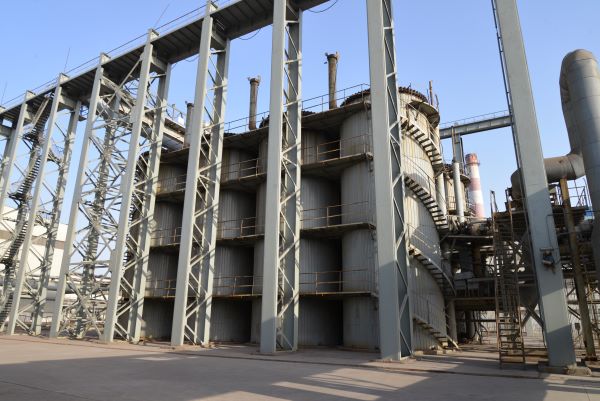


1. Principle
The main mechanism of activated carbon desulfurization is catalysis and adsorption. When gases containing sulfur and inorganic sulfur (H2S) pass through an active bed, exothermic reactions occur at atmospheric pressure. They are catalyzed and oxidized on the surface of the activated carbon to form elemental sulfur and water, which are then adsorbed by the activated carbon to achieve its desulfurization purpose.
Reaction equation:
2H2S+O2=2H2O+2S+Q
4NH3+4H2S+3O2=2(NH4)2S2O3
2NH3+H2S+2O2=(NH4)2SO4
COS+1/2O2=CO2+S
COS+2O2+2NH3+H2O=(NH4)2SO4+CO2
2. Desulfurization process
In activated carbon desulfurization, generally two activated carbon towers are connected in parallel, or multiple groups of activated carbon towers are connected in parallel, one or more desulfurization towers are used, and at least one standby tower is reserved.
During desulfurization, the desulfurization efficiency of activated carbon is affected by many factors, and the humidity in the gas is the main aspect, which generally needs about 70% content. But we should also pay attention to prevent the gas from carrying liquid. We need to regularly discharge the accumulated liquid from the bottom of the activated carbon bed. If the liquid accumulated in the activated carbon bed exceeds a certain height, the activated carbon will be soaked, which will lead to the early failure of the desulfurization performance at the bottom of the activated carbon. In addition, the coke layer at the bottom of the activated carbon bed may be blown over by the gas to make the activated carbon leak into the bed bottom and block the pipeline. When the gas passes through the activated carbon bed, it generally passes from bottom to top or from top to bottom. But at this time, the gas shall pass through a gas water separator first to prevent the gas from carrying liquid. When the desulfurization is in progress, the desulfurization efficiency shall be tested every 2-4 hours. When the content of hydrogen sulfide in the gas exceeds the use requirements after desulfurization, the activated carbon desulfurization tower will be replaced for desulfurization.
3. Regeneratin for Activated carbon
The activated carbon in the desulfuration tower after being replaced, because the sulfur element is constantly adsorbed in the gap during the desulfuration process, the desulfuration performance of the activated carbon decreases with the continuous accumulation of sulfur element, and it becomes saturated and loses the desulfuration function after a certain time, so it needs to be regenerated.
Superheated steam regeneration is a method with simple equipment, convenient operation and low regeneration cost, which is also the most commonly used method. In the process of hydrogen sulfide removal, activated carbon can remove a lot of sulfur .
Sulfur: it dissolves at 119 ℃ and boils at 444.6 ℃. The deposit on the activated carbon can also be decomposed into gas and liquid when heated, and separated from the activated carbon.
When regenerating the activated carbon, the steam shall be used first until the temperature of the activated carbon exceeds 100 ℃, and then the steam shall be heated by an electric heater or a gas heater. When the electric heater is used, the electric furnace wires shall be electrified one by one. When all the electric furnace wires are electrified, the superheated steam temperature shall be kept between 400 ℃ - 500 ℃ by controlling the steam flow. The steam flow is controlled by the pressure gauge behind the steam inlet valve. When the superheated steam enters the activated carbon bed, the sulfur and by-products adsorbed in the activated carbon micropore will desorb due to the increase of temperature, and will be discharged together with the steam. In the sulfur recovery tank, the liquid sulfur and gas sulfur are cooled by water to become solid block sulfur and settled at the bottom of the tank. The uncondensed gas is discharged from the chimney. When the temperature of the lower layer of the activated carbon bed reaches 350-360 ℃ and remains for about half an hour, the electric heater shall be stopped for heating, but the steam shall be continued for cooling. When the temperature of the lower layer of the activated carbon bed falls below 200 ℃, soft water can be added, and the steam shall be properly introduced to make the activated carbon bed soak with hot water to remove the residual ammonium sulfate on the surface of the activated carbon. After the hot water is discharged from the activated carbon bed, the temperature of the activated carbon bed will reach 100 ℃-110 ℃ after the steam is introduced for about 1 hour, so as to remove the liquid water accumulated in the activated carbon. At this point, the regeneration process of activated carbon is finished, and the activated carbon bed can be used again. Regeneration of an activated carbon bed generally takes 15-20 hours, of which the use time of the electric heater is 10-15 hours. On the second day after birth, the iron sheet cover on the sulfur recovery tank can be opened, the water in the tank can be drained from the diversion pipe at the lower part of the sulfur recovery tank, the sulfur block can be taken out, dried, packed and put into storage.
The regeneration of activated carbon by superheated steam is simpler than other regeneration methods, easier to operate and lower in cost. After regeneration, the adsorption performance is reduced least.